| |
|
 |
|
I have visited
several thousand country churches over
the last twenty years or so, and few
experiences are more haunting than to tip
up at some remote place and discover that
it was at one time one of the stars of
the Anglo-catholic firmament. Most
likely, it has long-since been subsumed
into the Church of England mainstream,
but that is not always the case.
Whatever, the evidence inside speaks of a
place which was once on the highest rung
of Anglo-catholic tradition, and Swilland
was such a place.
I remember, after I moved to Suffolk
thirty years ago, spotting St Mary across
the fields. My mind couldn't make sense
of what I was seeing. What was it? Some
strange Victorian folly? A water tower,
perhaps? It looks like nothing so much as
if a giant hand had picked up a Tudor
cottage, and threaded it delicately over
a lantern spire and onto the stump of the
tower. |
The hand, in fact, was that
of John Corder, an Ipswich architect remembered
by Corder Road in the town, where several houses
echo this Brothers Grimm fairy tale gothick. He
also rebuilt the church at Hepworth, although he
seems to have kept his imagination under wraps
there. Pevsner, in a rare moment when his sense
of humour shows through, described it as French
in character and vaguely of c.1500 in its motifs.
Sam Mortlock quite liked it, and called it
'beguiling'. He went as far as to describe the
lantern spire as 'perky'.
The village runs into the larger village of
Witnesham, which is outer-Ipswich suburbia
really, but Swilland still retains a sense of its
rural identity, and a feel of being a place where
ordinary people live quiet lives. There is an
excellent pub, the Moon and Mushroom. The name
Swilland means 'a place where pigs are kept',
although for miles around it is now barley which
sprawls across acre after acre. The main street
through Swilland is one of my regular ways back
into Ipswich from cycle rides, and so I see this
church often.
You enter the porch and
come to face with quite the most spectacular
Norman doorway in the Ipswich area. I think it
must have been recut a bit, but it reminds us
that this church was already old before the 15th
century tower and bell were installed, and that
it was ancient before John Corder came along.
The surprise comes as you step inside, for the
interior of this little church is redolent of
that gorgeous late 19th and early 20th century
Anglo-Catholicism, and while this may no longer
be the tradition at Swilland, it has left enough
of itself to show what it was once like. Your
eyes are drawn eastwards to a tall, gilt reredos
much in the style of Ninian Comper's at
Wymondham, the gilt Saints filling niches either
side of a crucifixion scene. I wonder who
designed it?
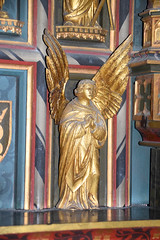 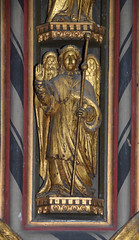  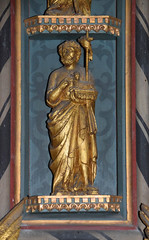 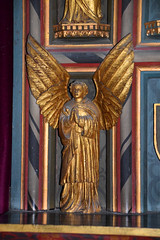
East Anglia's two great
Saints, St Felix and St Edmund, standin lights on
the south side of the nave with a brass
inscription to James Park Nelson and Philip
Bicknell bolted beneath them. Father Nelson and
Father Bicknell were the two priests who
established the Anglo-catholic tradition here at
Swilland and both are buried in the churchyard.
You can see their headstones below, Bicknell's a
grand, flowery cross, but Nelson's has succumbed
to the wear of time.
Back inside the church,
Nelson and Bicknell's memorial brass grows into a
Saxon cross inscribed with the words Jesu
Miserere, and the window was set by their
successor, Father Richard Faulconer. A third
figure to the west of the entrance shows St
Richard of Chichester and remembers Faulconer. He
had been ordained by Edward King, founder of the
Anglo-Catholic Keble College in Oxford and later,
as Bishop of Lincoln, champion of the
Anglo-Catholic cause in both his writings and in
the courts, which was often necessary in those
days of fierce resistance to anything considered
'Romish'. In tribute, the figures of St Felix and
St Richard, both of them Bishops, have been given
Edward King's kindly face.
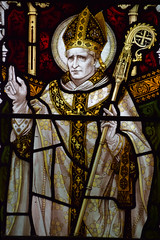 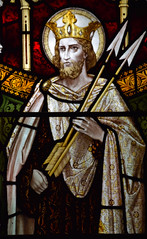 
The 15th
century font is painted in a 15th century style,
presumably also in the 1880s - you wouldn't have
got away with that in the 20th Century.
Curiously, directly opposite the window
remembering Father Nelson and Father Bicknell is
a memorial to a minister of some twenty years
earlier. Richard John Allen appears to have died
in harness in 1867, when Tractarian attitudes,
and what it must be said was a snobbish attitude
to the the literalism and triviality of Biblical
fundamentalism, were already firmly entrenched in
the Church of England.
But Allen's
memorial is surmounted by an open book
with the words ye must be born again,
a typically hardline response to
Tractarian ideas about sacramental grace.
Beneath we are told that he Faithfully
Preached the Glorious Gospel of the Grace
of God. And this just twenty years
before Faulconer's call for Jesu
Miserere - it must have been quite a
rollercoaster ride in this quiet little
parish in those days when either party
could accuse the other pharisaism, and
frequently did.
And yet, the Anglo-catholic party won in
the short and medium term, and in the
long term altered the face of the Church
of England. For it had something that the
biblical fundamentalists could not
compete with - beauty. Evidence of this
is a remarkable survival in the form of
the processional banner worked by Father
Faulconer himself, in velvet and gold
thread, studded with coloured beads. It
shows a crowned rose as an emblem of the
Blessed Virgin Mary. Near to it on on the
north wall is one of the best carved sets
of royal arms in Suffolk. It is that rare
thing, a set for Queen Anne. |
|
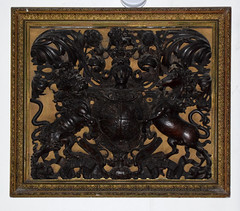 |
|
|
|

